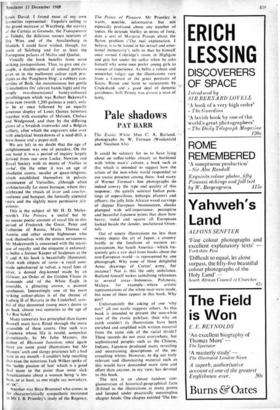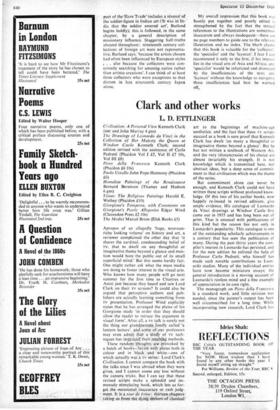Pale shadows PAT BARK The Exotic White Man C. A.
Burland, photographs by W, Forman (Weidenfeld and Nicolson 63s)
It could be salutary for us to have lying about on coffee-tables already so burdened with 'white man's' culture, a book such as this which is intended to suggest how the artists of the non-white world responded to our exotic presence among them. And many of Werner Forman's fine photographs do indeed convey the type and quality of this response: the quietly satirical Indian pain- tings of supercilious, lethargic planters and officers; the jolly little African wood carvings of dapper European businessmen, cheeks plumped with self-importance; perceptive and beautiful Japanese prints that show how heavy, stolid and square all Europeans looked beside the slender, uncluttered Orien- tals.
Out of ninety illustrations no less than twenty depict the art of- Japan, a country hardly in the forefront of western ex- pansionism, but South America—which fre- quently gets a raw deal from books about the non-European world—is represented by one photograph. Why none of those delightful Aztec drawings of Cortes' army, for instance? Nor is this the only imbalance. Burland himself makes tantalising references to several areas—Indonesia, Polynesia, Malaya. for example—where artistic representations of the white man were made, but none of them appear in this book. Why not?
Unfortunately the asking of one 'why not?' all too easily suggests others. As this book is intended, to present the non-white view of the exotic paleface, then why on earth couldn't its illustrations have been enriched and amplified with written material from the same side of the racial divide? These records do not exist everywhere, but sophisticated peoples such as the Chinese, Indians, Japanese produced many revealing and entertaining descriptions of the en- croaching whites. However, to dig out truly relevant and illuminating material such as this would have demanded more time and effort than anyone, in my view, has devoted to this book.
The text is an almost random con- glomeration of historical-geographical facts ill-fitted to the illustrations at many points and lumped under practically meaningless chapter heads. One chapter entitled 'The Im-
pact of the Slave Trade' includes a résumé' of the soldier-figure in Indian art (It was in In- dia that the soldier entered art', Burland begins boldly); this is followed, in the same chapter, by a general description of missionary influence. Staggering half-truths abound throughout: nineteenth century col- lections of foreign art were not representa- tive, Burland says, 'because the artists chosen had often been influenced by European styles p . . also because the collectors were con- sciously searching for amusing curios rather than artistic creations'. I can think of at least three collectors who were exceptions to that dictum in late nineteenth century Japan alone. My overall impression that this book was hastily put together and poorly edited is strengthened by the fact that the textual references to the illustrations are sometimes inaccurate and always inadequate—there are no page numbers to guide one to the relevant illustration and no index. The blurb claims that this book is valuable for the 'collector-, the 'specialist' and the 'layman'. I fear I can recommend it only to the first, if his interest lies in the visual arts of Asia and Africa; anv `specialist' would be infuriated and dismayed by the insufficiencies of the text; any `layman' without the knowledge to recognise these insufficiences had best be warned off.















































 Previous page
Previous page